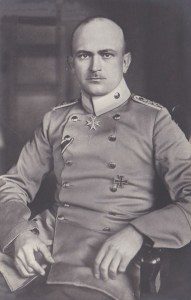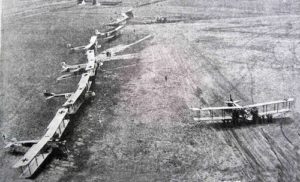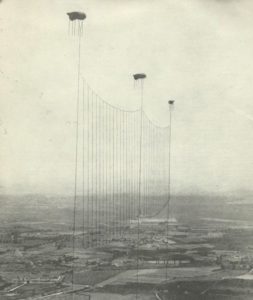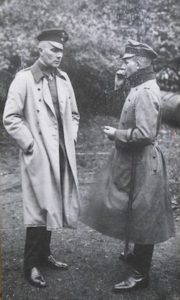Artículo Military History, 17.08.2017 Ian Castle, historiador militar británico especializado en la I Guerra Mundial
Analysis of the German air offensive against London in 1917-1918
A hundred years ago this summer, German aircraft opened a shocking aerial campaign against London. Whereas the much-feared Zeppelins had appeared furtively under the cloak of darkness, the Gotha bombers appeared brazenly in broad daylight.
The raids had a wide-ranging impact – from laying the foundations of an aerial defence system that helped Britain defeat the Luftwaffe in the Second World War to changing the name of the Royal Family!
In the opening months of the First World War, no one yet knew the impact aviation would have on armed conflict. No strategic bombing campaigns had previously been undertaken.
Initially, the threat to Britain came from Germany’s airships, but when that threat largely evaporated with the introduction of explosive and incendiary bullets in the second half of 1916, the challenge of taking the war to Britain fell to the bomber aircraft of the German Army.

Hauptmann Ernst Brandenburg (1883-1952). After having been wounded in 1915, Brandenburg transferred to the Army’s aviation arm, where his ability as an organiser and administrator brought him to the attention of his superiors. With his calm and calculating manner, Brandenburg seemed to be the ideal man to head Kagohl 3.
Aircraft development meant that the GIV variant of the G-type bomber, the Grosskampfflugzeug, had the ability to fly to London and back, carrying a bomb load of 300kg to 400kg. Better known as the Gotha, the first of this type was delivered in March 1917.
The Gothas would form a new squadron to take the war to England from Belgium – Kampfgeschwader 3 der Oberste Heeresleitung (Battle Squadron 3 of the Army High Command) – conveniently abbreviated to Kagohl 3 and known unofficially as the Englandgeschwader (England Squadron).
The man appointed to command it was a former infantry officer, 33-year-old Hauptmann Ernst Brandenburg. He started with a blank piece of paper: there were no guidelines for creating an overseas bombing squadron.
The first raids
By May 1917, Kagohl 3 was ready. At the same time, the absence of any Zeppelin raids on London since early October 1916 had convinced the British authorities that the threat of aerial attack against the capital was over. As Britain downgraded its defences, Germany struck.
On 24 May, Brandenburg ordered Kagohl 3’s first attack on London, but the weather thwarted him. With thick cloud protecting the capital, Brandenburg attacked secondary targets in Kent, where his bombs claimed 96 lives and left 195 injured.
Although the Royal Flying Corps (RFC) and Royal Naval Air Service (RNAS) had 77 aircraft airborne, most of them were no match for the high-flying Gothas. It was clear, moreover, that it was only a matter of time before the Gothas reached London. This they did, spectacularly, on Wednesday 13 June 1917.
As the formation of 14 Gothas bore down on the capital, the noise they created was immense, yet many of those watching, staring skywards on that warm, hazy summer’s morning, presumed them to be British and cheered enthusiastically as they passed.
Word of the approaching formation reached Home Defence headquarters, and aircraft took to the skies as the first anti-aircraft (AA) gun opened fire from Romford in Essex at 11.24am.
The Englandgeschwader dropped a few bombs over east London, then, as the squadron reached Regent’s Park, Brandenburg fired a signal pistol and the formation turned back to the east, setting a direct course to the City of London.
Kagohl 3 dropped 118 high-explosive bombs on the capital, 72 landing within a one-mile radius of Liverpool Street Station. Those bombs killed 162 and injured another 426, the highest toll from any single raid on Britain since the beginning of the war. Among the many tragic stories to emerge that day, there was one above all others that left an indelible mark on the city.
One 50kg high-explosive bomb struck Upper North Street School in Poplar. It penetrated three storeys before exploding in an infants’ class on the ground floor of the building. Desperate rescuers pulled the lifeless, mangled bodies of 18 children from the wreckage; another 28 emerged bearing cruel injuries.
Air-defence Crisis
Summoned to Germany to report on his successful mission, Brandenburg received the country’s highest military order – the Pour le Mérite.
His joy was short-lived. On the return journey, his aircraft crashed and, although he was dragged alive from the wreckage, Brandenburg lost a leg. Command of Kagohl 3 passed to Hauptmann Rudolph Kleine.
The Home Defence organisation had appeared impotent in the face of the raid, while the feeling of outrage among the public was immense. Plans to increase the size of the RFC received quick approval, and in the short-term two front-line squadrons were withdrawn to assist against further Gotha raids – with the important proviso that both would be returned to their normal duties in three weeks to support a major attack at Ypres. The authorities also earmarked new, more effective aircraft for the Home Defence squadrons, better able to engage the Gothas.

Gotha GIV bombers of Kagohl 3 on an airfield in Belgium in 1917, preparing for a daylight raid on England.
Back in Belgium, Kleine waited for a break in the bad weather. It finally came on 7 July. On the previous day, with some irony, the last of the aircraft temporarily assigned to Home Defence had returned to duties on the Western Front.
On a bright, sunny morning, Kleine led a formation of 21 Gothas to England. At 10.20am, the first AA gun opened fire. Others all over London soon joined in as the Gothas attacked in two waves.
Their bombs fell from Stoke Newington to the City of London, killing 54 and injuring 190, with material damage estimated at about £205,000. An eclectic mix of 79 RFC aircraft, joined by 22 of the RNAS, were in the air, and a series of confused individual attacks unfolded.
One Gotha came down in the sea, another crashed on the beach at Ostend, with three more wrecked when landing. The British lost a Sopwith Pup and a Sopwith 1½ Strutter.
Angered by the apparent ease with which the Gothas attacked London, sections of the bombed population turned against immigrants in their midst. With this depth of ill feeling, King George V diplomatically changed the name of the Royal Family from Saxe-Coburg-Gotha to Windsor.

The balloon apron across the eastern approaches to London was introduced to help against the night raids. Spans of cable, each about 1,000 yards wide, were held aloft by three balloons; each carried cables that hung down for about 1,000 feet, spaced at 25-yard intervals. Hoisted up to a height of about 10,000 feet, the aprons offered an obstacle to raiders, and forced them to fly at a more predictable height.
Air-defence Action
In response to the raids, the War Cabinet formed a committee to consider the question of home defence and aerial operations. Its findings were largely the work of one man, a former Boer guerrilla leader, now Lieutenant- General Jan Christian Smuts.
Within eight days, Smuts presented his report. It led to the creation of a London Air Defence Area, bringing the RFC squadrons, anti-aircraft guns, searchlights, and Observation Corps committed to the defence of the capital under a united command.
The man chosen to lead it was Brigadier- General Edward Ashmore, a former RFC officer and, at the time, an artillery commander in Flanders. He took up his new post on 5 August 1917.
Bad weather gave Ashmore time to oversee improvements to London’s defences. By redeploying some of London’s guns, an outer line was created 25 miles outside the capital to break up incoming Gotha formations. Ashmore then created a ‘Green Line’ around London. Beyond this line, the guns had priority, allowing the gunners to consider any aircraft over this zone as hostile. He hoped separate zones of operation for aircraft and guns would reduce incidents of ‘friendly fire’.
Smuts had one more important recommendation concerning the future of airpower. He proposed the RFC and RNAS combine into a single air service. It marked the birth of the Royal Air Force, which finally came into being on 1 April 1918.
All these plans to counter daylight raids were, however, about to become redundant. Increasing losses suffered by Kagohl 3 while raiding coastal towns in July and August 1917 highlighted the futility of continuing on this course, and prompted Kleine to switch to night bombing.
The first night raids
Kleine’s first night raid on London took place on 4 September. Gone was the formation flying of the daylight raids; now the Gothas took off at five-minute intervals to avoid collisions in the dark.
Nine Gothas reached England, but just five got as far as London. These caused damage estimated at £42,000, while killing 16 and injuring 56. Surprised by this change of tactics, only 18 British aircraft took to the night sky to search for the raiders, and just two caught fleeting glimpses of the enemy.
In September, a new squadron joined the campaign against London when Riesenflugzeugabteilung (Rfa) 501 arrived in Belgium with the R-type bomber – the Riesenflugzeug (literally, ‘giant aeroplane’).
Commanded by Hauptmann Richard von Bentivegni, these extraordinary aircraft, somewhat ungainly in appearance, had a crew of seven or eight and could carry a very large bomb-load. They were most remarkable for their size. With a wingspan of 138ft, they dwarfed by over 30ft both the Lancaster and the B17 Flying Fortress, iconic bombers of World War II.
The advent of a period of favourable weather in late September heralded a concentrated period of bombing during which six raids took place across a period of eight days, with five of them striking London.
Despite the intensity of the raids, the results were disappointing for Kleine. Just 94 explosive and 57 incendiary bombs had been dropped, causing material damage estimated at £118,000, with casualties in London confirmed at 50 killed and 229 injured.
The raids were, however, having potent indirect effects. Production of munitions at Woolwich Arsenal fell significantly during the raids, and as many as 300,000 Londoners spent their nights sheltering in Underground stations, experiencing stress, anxiety, and shattered nerves.
These nights proved traumatic for some of the Gotha crews too. The AA guns responded with a barrage reported as ‘unprecedented in this country’. On the night of 30 September, the guns in south-east England fired 14,000 shells at ten raiding Gothas. Many Gotha commanders now chose to turn away from London and bomb secondary targets rather than take their chance with the guns.
More incendiaries

Hauptmann Rudolf Kleine took command of Kagohl 3 after Brandenburg suffered serious injury when his aircraft crashed. Whereas Brandenburg was calm and calculating, Kleine could be impatient and rash.
When Kleine made his next strike on 31 October 1917, he loaded an increased percentage of incendiary bombs, as he now planned to set great fires burning across London. Again, he was to be disappointed.
That night, strong winds disrupted the attack. Only 40 explosive bombs and 37 incendiaries fell in London, causing damage calculated at just £9,500. It got worse for Kleine, as fog shrouding their home airfields resulted in the wrecking of five of his returning bombers.
For the next raid, on the night of 5/6 December, Kleine could call on 19 Gothas, and they were joined by two Giants. But only six of his Gothas reached the city. The 260 incendiary and 13 high-explosive bombs they dropped started only three serious fires, and that night British morale received a boost when the overworked guns brought down two of the raiders.
Kleine’s great hope to set London ablaze had failed. An official German historian later acknowledged that the incendiary bombs were not fit for purpose. Kleine would not get another chance. Six days later he was shot down and killed near Ypres.
Temporary command passed to the squadron’s senior flight commander, Oberleutnant Richard Walter. A week later Kagohl 3 was redesignated Bombengeschwader 3 der Obersten Heeresleitung (Bogohl 3).
On the 18 December, Walter led Bogohl 3 to London. Six Gothas fought their way through the barrage, as did a single Giant, and their bombs caused damage estimated at £225,000, the greatest in a single attack since the Zeppelin raid on central London on the night of 8/9 September 1915.
The raiders did not have it all their own way. Captain G W Murlis Green, commanding officer of No.44 Squadron, shot down a Gotha after it had bombed Bermondsey, the first loss in air combat since the night offensive commenced. Seven others were lost or damaged in landing accidents back in Belgium.
Thick fog blanketing London through most of January 1918 grounded Bogohl 3 and Rfa 501, and it was not until 28 January that three Gothas and a Giant were able to battle their way through to the capital.
Combined attacks by two Sopwith Camels over Essex saw one Gotha crash in flames at Wickford. Elsewhere, though, a 300kg bomb dropped by Giant R12 on Odhams Printing Works in Long Acre, Covent Garden, had a devastating impact.
About 600 people had gathered in the basement as the building served as an official air-raid shelter. The blast shook the foundations and caused huge fires, and a wall collapsed, allowing the massive printing presses to crash down into the basement.
It took six weeks to clear the rubble and recover the last two bodies. The bomb had killed 38 and injured 85 – the highest total in London from a single bomb.
Destruction caused at Odhams Printing Works by a 300kg bomb dropped from Giant R12. 38 killed and 85 injured.
Brandenburg’s return
In February 1918, after seven months’ convalescence and walking with difficulty on an artificial leg, Ernst Brandenburg returned to command Bogohl 3. He found his squadron much demoralised by their regular losses, and immediately suspended further action until Bogohl 3 returned to full strength.
This meant that the Giants of Rfa 501 made the next three raids in February and March alone. On two of those occasions, R39 carried a single 1,000kg high-explosive bomb, the largest to be dropped from the air during the war.
The first, on 16 February, struck the Royal Hospital in Chelsea, home to the Chelsea Pensioners, and the second, on 7 March, smashed into houses in Warrington Crescent, a quiet residential street in Maida Vale. The destructive impact of the bombs over a wide area was immense.
London expected more raids to follow, but on 21 March the German Army launched a massive spring offensive on the Western Front and all aircraft were required to support the attack. It was not until May 1918 that the bombers returned to London.
On the night of 19/20 May, 38 Gothas and three Giants set out for London, the largest aerial armada yet assembled. Reports from observer posts all over south-east England flooded into London’s Air Defence headquarters. For the first time, aircraft of the recently amalgamated Royal Air Force took off to oppose the raiders, and soon the skies over Kent and Essex buzzed like a hornets’ nest, while the guns of the London Air Defence Area thundered into the darkness.
The last big raid
Only 18 of the 41 attacking aircraft battled their way through the storm of shot and shell, with the rest repulsed by this onslaught or forced to turn back with engine problems. Of the 72 bombs that fell over a wide area of London, just a handful struck at its heart. Even so, they claimed 48 lives and injured 172. But, having spent as little time as possible over London, the raiders then faced a hazardous return journey fraught with danger.
That night, the London guns fired over 30,000 rounds skywards, and 86 RAF aircraft swarmed in the skies. One Gotha was shot down over East Ham, two over Kent, another made an emergency landing near Clacton, while anti-aircraft guns brought down two more off the coast, and one crashed on landing in Belgium.
Quiet now returned to the skies over London. The city’s population steeled itself for the next alarm, while the RAF confidently awaited their next test. A week passed, then a month, two months, still more time, but the raiders did not return. In fact, they never came again.
Increasing demands from the Army in the second half of 1918 meant Bogohl 3 and Rfa 501 were unable to return to London. There was a plan in September 1918 to unleash a firestorm on the city when a new lightweight but effective incendiary – the Elektron bomb – became available, but the raid was cancelled at the last moment. With British aircraft now bombing German towns and cities, the German Army High Command feared even greater reprisals against the civilian population. For London, the war was over.
The impact
The bomber raids on the London area resulted in 487 deaths and 1,434 other casualties. Across the rest of south-eastern England, mainly in coastal towns, another 350 died with 557 injured in aeroplane attacks.
But Germany’s plan to crush the morale of London’s population by aerial bombardment had failed. Rather than demand peace, Londoners had called for reprisals.
But the raids did have an impact. They had forced the deployment of high-performance aircraft away from the front-line and had, at times, affected munitions production. And despite urgent demands for their redeployment, the guns, the searchlights, and the manpower required to complete the defence system remained firmly in place until the end of the war.
Yet this came at a price. Bogohl 3 lost 24 Gothas shot down or missing, with another 36 destroyed or seriously damaged in landing accidents, and Rfa 501 also lost three Giants in bad landings. In comparison, the Home Defence squadrons lost 16 aircraft.
And Britain gained a significant – and as yet unsuspected – benefit from the raids. The defence system that had evolved (later enhanced by radar) would be the backbone of the nation’s response just over two decades later, when German aircraft again appeared in Britain’s skies, in the summer of 1940.

